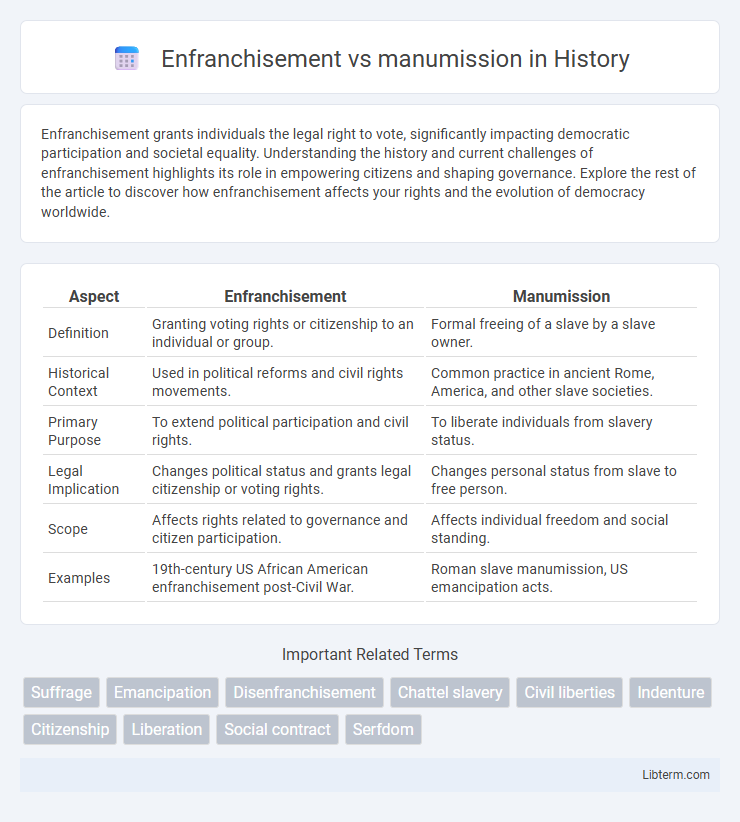Enfranchisement grants individuals the legal right to vote, significantly impacting democratic participation and societal equality. Understanding the history and current challenges of enfranchisement highlights its role in empowering citizens and shaping governance. Explore the rest of the article to discover how enfranchisement affects your rights and the evolution of democracy worldwide.
Table of Comparison
| Aspect | Enfranchisement | Manumission |
|---|---|---|
| Definition | Granting voting rights or citizenship to an individual or group. | Formal freeing of a slave by a slave owner. |
| Historical Context | Used in political reforms and civil rights movements. | Common practice in ancient Rome, America, and other slave societies. |
| Primary Purpose | To extend political participation and civil rights. | To liberate individuals from slavery status. |
| Legal Implication | Changes political status and grants legal citizenship or voting rights. | Changes personal status from slave to free person. |
| Scope | Affects rights related to governance and citizen participation. | Affects individual freedom and social standing. |
| Examples | 19th-century US African American enfranchisement post-Civil War. | Roman slave manumission, US emancipation acts. |
Introduction to Enfranchisement and Manumission
Enfranchisement refers to the granting of citizenship or voting rights to individuals, often transforming their legal status and enabling participation in civic activities. Manumission is the formal process by which a slave owner frees their enslaved person, legally ending the individual's bondage and allowing personal liberty. Both concepts signify a shift in social and legal status but operate in distinct contexts--enfranchisement in political rights and manumission in personal freedom.
Historical Context of Enfranchisement
Enfranchisement historically referred to granting citizenship rights, including voting, to individuals or groups previously excluded, often within colonial or post-slavery societies. It was a legal and political process closely tied to expanding democratic participation and civil liberties, especially in 18th and 19th-century Western nations. Unlike manumission, which specifically freed enslaved persons, enfranchisement encompassed broader social and political inclusion beyond individual liberation.
The Evolution of Manumission Practices
Manumission practices evolved significantly from ancient to modern times, shifting from informal declarations of freedom by slave owners to legally codified procedures ensuring rights for freed individuals. In Roman law, enfranchisement often granted not only freedom but also citizenship, linking manumission to social and legal status changes. Modern systems have institutionalized manumission through formal legal frameworks, focusing on human rights and reintegration, contrasting with earlier practices driven primarily by owner discretion.
Key Differences Between Enfranchisement and Manumission
Enfranchisement refers to granting an individual full civil rights, often including the right to vote, whereas manumission is the formal act of freeing a slave from bondage. Enfranchisement emphasizes legal and political empowerment, while manumission centers on personal liberation and emancipation from servitude. These differences highlight enfranchisement as a civic process and manumission as a social and legal release from slavery.
Legal Implications and Processes
Enfranchisement grants individuals full citizenship rights, typically involving legal procedures that formalize political and civil status changes, such as voting rights and property ownership. Manumission specifically refers to the legal act of freeing a slave, requiring documentation or court approval to alter the individual's status from enslaved to free person. Both processes are governed by distinct statutes and involve formal legal recognition, but enfranchisement centers on granting rights within an existing free population, while manumission transforms an individual's fundamental legal status.
Social and Economic Impacts
Enfranchisement granted former slaves political rights, fostering social integration and expanding democratic participation, which contributed to shifts in power dynamics and economic opportunities within communities. Manumission, the legal act of freeing enslaved individuals, primarily impacted social structures by altering family units and labor systems while creating a class of free laborers influencing local economies. Both processes challenged existing hierarchies, but enfranchisement specifically empowered freed individuals with voting rights, facilitating broader social reforms and economic mobility.
Enfranchisement in Global History
Enfranchisement historically refers to the granting of political rights, such as the right to vote, often marking the transition of individuals or groups into recognized members of a civic body. In global history, enfranchisement has played a critical role in movements for civil rights and democracy, including the abolition of property requirements for voting and the extension of suffrage to women and marginalized populations. Unlike manumission, which specifically denotes the release of slaves from bondage, enfranchisement emphasizes the legal empowerment and political inclusion of citizens within a society.
Manumission and Its Role in Abolishing Slavery
Manumission, the act of a slave owner voluntarily freeing their enslaved individuals, played a crucial role in the gradual dismantling of slavery by legally recognizing freedom without government intervention. This practice not only granted personal liberty but also set important legal precedents that challenged the institution of slavery, influencing broader emancipation movements. Historical manumission records reveal complex social dynamics and contributed to the evolving legal frameworks that paved the way for widespread abolition.
Modern Interpretations and Relevance
Enfranchisement in modern contexts extends beyond granting voting rights to include empowerment through legal recognition and civic participation, often linked to citizenship and social equality. Manumission today is interpreted as the formal liberation from various forms of bondage or systemic oppression, highlighting legal reforms and human rights advancements. Both concepts remain relevant in contemporary discussions on freedom, citizenship, and social justice, influencing policies and advocacy worldwide.
Conclusion: Legacy and Continuing Debates
Enfranchisement and manumission both represent critical legal mechanisms that transformed the status of enslaved individuals, yet their legacies diverge in scope and impact. Enfranchisement granted political rights, often limited and contested, while manumission primarily offered personal freedom, creating complex social dynamics and inequalities. Contemporary debates on racial justice and reparations continue to examine these distinctions, highlighting their lasting influence on citizenship, systemic inequality, and social inclusion.
Enfranchisement Infographic

 libterm.com
libterm.com